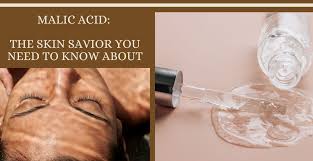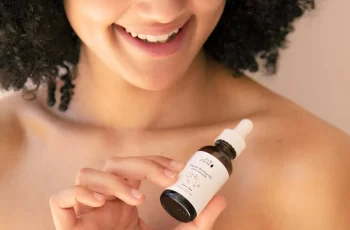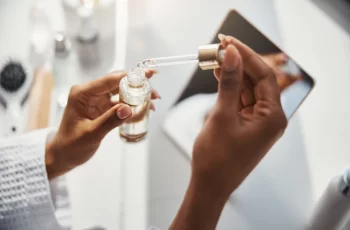Malic Acid Skin Care Benefits – Why is it Good for Skin?
An apple a day keeps the doctor away, that’s what the famous saying goes! Not only are apples a healthy snack, but the acid they contain is also very beneficial for the skin. Malic acid is part of the alpha hydroxy acid family and admittedly, it’s not as popular or well-known as other acids like lactic acid or hyaluronic acid. But it can deliver incredible results for your complexion. Learn more about this acid in this guide.
What is Malic Acid?
You’ll find that malic acid is produced naturally in the body and supports movement by converting carbohydrates into energy. Without malic acid, getting from A to B would be a lot harder.
For cosmetic purposes, malic acid is extracted from fruits like apples and pears. It’s considered part of a group of chemical peels called alpha hydroxy acids. Of all the AHAs, malic acid has been the least studied, but the research that has been done suggests that this acid has many useful properties, both as a dietary supplement and as a skin care product.
First isolated from apple juice in 1785, malic acid has been used in the food and beverage industry for centuries to give products a sour taste. Fast forward to the present, and you might be surprised to learn that malic acid is found in many skin and hair care products, such as:
Shampoo
Body lotion
Nail care
Acne treatment
Anti-aging products
And many more
Malic acid is primarily used by skin care professionals as part of chemical peels, as the acid is valued for its ability to brighten the skin and smooth uneven texture.
Similar to its AHA analogs, malic acid stimulates exfoliation by preventing the breakdown of cohesive bonds within dead epidermal cells. As chemical bonds are broken and dead skin cells are removed, your complexion will appear more radiant and less prone to blemishes.
Another use for malic acid is oral ingestion in the form of a dietary supplement or tonic to relieve symptoms such as dry mouth, carotid pain, and fatigue. Dosage of the acid must be considered, more on that later.
What are the main benefits of malic acid?
We have already briefly touched on some of the benefits of malic acid, and now we will take a closer look at the main benefits of malic acid and how it can affect you and your skin.
Malic acid prevents breakouts and blemishes
Malic acid is a great ingredient for preventing acne breakouts such as pimples and blackheads. The exfoliating properties of the acid remove dead skin cells that contribute to a dull complexion. The buildup of these cells, along with dirt, bacteria, and excess sebum, can lead to the formation of pimples and other skin imperfections. By penetrating the lower layers of the skin, malic acid cleans the pores and removes dead skin cells from the face. You’ll also find that pigmentation, scarring, and other skin issues that often accompany breakouts are treated.
Malic Acid Restores pH and Hydrates the Skin
Similar to hyaluronic acid, malic acid is a humectant. What I mean by this is that it holds onto moisture and keeps the skin hydrated. Perfect for anyone with dehydrated skin, which is often confused with skin that shows signs of aging.
Malic acid is often used as an ingredient in cosmetics for its pH balancing properties. When the skin’s pH is imbalanced, the skin’s protective barrier becomes unstable, making the skin more susceptible to dryness, irritation, and breakouts. Unlike other acids, malic acid has the unique ability to maintain a balanced pH for a longer period of time.
People with eczema should also note that malic acid can soothe and irritate the skin, as well as moisturize it. Using malic acid to treat skin conditions must be considered very carefully, as its short-term and long-term effects are unknown.
Malic Acid Helps Fight Aging and Pigmentation
Malic acid promotes a high turnover rate for skin cells, meaning that the shedding process of old skin cell layers is faster than the usual 30-day cycle, resulting in:
Less noticeable fine lines and wrinkles
Even skin tone
Smoother skin texture
Firmer, plumper-looking skin
Fewer skin blemishes
As we age, our bodies produce less collagen, causing our skin to lose firmness and elasticity. Using higher concentrations of malic acid also allows the acid to penetrate deeper into the skin layers and increase collagen formation. Because malic acid supports collagen production, the skin appears firmer, plumper, younger, and the signs of aging are significantly reduced.
When it comes to skin pigmentation, malic acid speeds up cell turnover, causing dark spots and pigmentation to become less noticeable over time. An important factor to consider is that as new skin cells become visible, the skin becomes sensitive to the sun’s UV rays. Using a high SPF is an important part of your skin care routine.
A 2013 study investigated a group of people with melasma. The study participants used a daily skin care routine containing vitamin C and malic acid, and the effectiveness of these ingredients on melasma was monitored. After 26 months of follow-up, both ingredients were found to have short-term benefits.
How to use malic acid and the right amount
For skin care products such as cleansers and creams, malic acid is formulated in lower amounts and diluted for daily use for up to 60 days. Other conditions, such as fibromyalgia syndrome, can be treated with a product called “Super Malate,” which is a combination of magnesium and malic acid, taken twice daily for 6 months.
The appropriate dosage of malic acid also depends largely on how you use the ingredient, whether as a dietary supplement or topically. Other considerations include your age, gender, and medical history.
What are the side effects of malic acid?
You will find that certain AHAs have some side effects that you should be aware of. Here are the main issues that arise when using malic acid.
Oral:
Headache
Diarrhea
Nausea
Allergic reaction
Theme:
Itching
Redness
Increased sensitivity to sunlight
Introducing an AHA into your skincare routine is something that requires careful consideration and patch testing. If you feel your skin will be happy when you start using this AHA, be sure to find the dosage and product that works for you and your skin. If not, you’re better off with apples, and if you put them in the cake, even better!
Want to find another AHA to give your skin a healthy glow without worrying too much? Then read our guide to hyaluronic acid.
DQH Knowledge drop: In your 20s, your skin cell turnover decreases. (Cell turnover is a key component in keeping your skin youthful.) You know what else slows down? Your collagen production. Starting in your 20s, collagen decreases by about 1 percent per year. Should you want to prevent fine lines and wrinkles, start by eliminating behaviors that contribute to premature aging. “If it’s bad for you, it’s bad for your skin,” says dermatologist Michel Somenek.
“Cigarette smoking reduces blood flow to the skin and causes premature wrinkling and a dull skin texture. Making the repeated pursed motion to inhale can also cause smoker’s lines. Alcohol and recreational drugs are toxins for the skin that damage its cellular structure and DNA,” Somenek tells us. “The faster you eliminate vices while you are young, the better chance your skin and body have to recuperate.” Also, adopting an anti-aging routine in your 20s is key. After all, the best offense is a good defense. We spoke to Somenek and experts Joshua Ross and Audrey Kunin to find out more.
Keep reading for the best anti-aging products for your 20s, according to skincare professionals.
Sunscreen
“We all know that the sun is the number one cause of skin aging and starting the prevention in your 20s is very important,” Ross says. “The majority of your sun damage won’t start to appear until you’re in your 30s, so don’t wait until you see it surface or you’ll be behind the curve. Stay ahead of it with a good-quality zinc-based sunscreen worn daily.”
Farmacy Green Defense Daily Mineral Sunscreen
An invisible sunscreen with SPF 30, plus botanical extracts meant to protect skin with tons of antioxidants. Bonus: It’s clean and fine to use under makeup.
Bareminerals Complexion Rescue™ Tinted Moisturizer Broad Spectrum SPF 30
Although we recommend you use your SPF and moisturizer separately, we also understand moments when you don’t have time or energy for that extra step. For those times, this bareMinerals moisturizer is a great thing to have on hand.
Vitamin C Serum
“A great introduction to anti-aging is to start with a vitamin C serum in your morning skincare routine,” Ross says. “It’s a powerful antioxidant that will neutralize free radicals and brighten the skin.” He adds that it’s a great way to counteract the effects of the sun’s harmful rays, which, as previously mentioned, are among the biggest causes of premature aging.
Drunk Elephant C-Firma™ Vitamin C Day Serum
The Drunk Elephant C-Firma is a lightweight serum that promises to give skin a glow by combining the brightening powers of vitamin C with ferulic acid, l-ascorbic acid, and vitamin E. The included sodium hyaluronate is meant to replace hydration loss, so you shouldn’t have to deal with any irritation.
Sunday Riley C.E.O. Rapid Flash Brightening Serum
This potent serum is jam-packed with vitamin C (15 percent, to be exact), which means it’s a potential superstar at both brightening skin and dousing it in antioxidants.
Peptides
Using peptides on your skin has many benefits, says Somenek. “The skin barrier is what defends the body against pollution, UV rays, bacteria, and toxins. It can be damaged by several everyday factors. Using topical peptides aids in building a stronger barrier,” he says. “Peptides comprise elastic fibers, which are a type of protein. These fibers help to make skin appear taut and firm. Peptides can also help repair damaged skin, relieve inflammation, and even out skin tone. Some peptides can kill acne-causing bacteria that is common in 20-somethings.”
Kunin agrees, saying, “Peptides are an excellent entry point for supporting collagen.” She recommends looking for face and eye treatments that contain these collagen-boosting powerhouses.
Charlotte Tilbury Magic Eye Rescue Cream
This Charlotte Tilbury super-emollient eye cream has a base of coconut oil and shea butter (read: it’s incredibly hydrating). Botanicals plus peptides are meant to help reduce dark circles and boost collagen, respectively.
This creamy moisturizer serves up potent collagen-boosting peptides and pycnogenol, and antioxidant-rich vitamin C. “Instead of sitting on top of the skin, peptides penetrate the outer layer so they go deep. The ‘signals’ they send tell the cells to produce elastin and collagen, which are needed for youthful-looking skin,” explains Somenek.
At-Home Peel Pads
Remember that skin cell turnover fiasco we talked about earlier? One way to help support it is by exfoliating. “Exfoliation is important to help keep skin fresh and luminous,” Kunin says. She recommends using at-home peel pads as an easy and effective way to exfoliate.
“The goal in your 20s is to fight the slowing pace of cell turnover. It is wise to use products that gently exfoliate, yet still remove oil and other impurities. Products that have Alpha Hydroxy Acids (AHA) or Beta Hydroxy Acids (BHA) are a good choice.”
According to Somenek, you should only exfoliate two to three times a week. “People of all ages are guilty of over-exfoliating and that can be too much of a good thing,” he says.
Dermadoctor Kakadu C Intensive Vitamin C Peel Pad
A few swipes of this Derma Doctor powerful peel pad promise to leave your skin glowing and smooth, thanks to the seven (yes, seven) types of chemical exfoliants, including AHA and BHA. It also contains vitamin C via Kakadu plum extract for added brightening and antioxidant protection.
KEY INGREDIENTS Kakadu plum extract is sourced from the Kakadu plum, a fruit grown in northern Australia. It contains vitamin C, which restores the skin’s natural barrier, increases collagen production, and soothes irritation.
Dr. Dennis Gross Skincare Alpha Beta® Universal Daily Peel Pads
These are the gold standard of peel pads, with a cult following and over 900 five-star reviews on Sephora. They’re easy to use and contain a blend of anti-aging exfoliating acids.
Emollient Night Cream
“In your 20s, you need to start upping the hydration in your skincare routine. You may have been cautious of over-moisturizing because of acne in your teens, but as you enter your 20s, your skin transitions and becomes drier,” Ross says. “I recommend an emollient night cream added into your evening skincare regimen.”
“Twenty-somethings need to make sure that they are not using creams that will clog their pores and cause excess oil production,” says Somenek. Opt for non-comedogenic products.
Cerave Skin Renewing Night Cream
One great choice is the CeraVe Skin Renewing Night Cream, which is a non-comedogenic night cream that leaves skin soft and glowy. It combines the moisturizing powers of ceramides and hyaluronic acid.
RoC Retinol Correxion Max Hydration Creme
“The best night cream ingredients contain retinol, benzoyl peroxide, and/or salicylic acid or hyaluronic acid. The goal is to moisturize, yet remove excess oil,” says Somenek. This Roc Retinol Correxion cream fits the bill as it contains both hyaluronic acid and retinol so it promises to moisturize while also being non-comedogenic.



